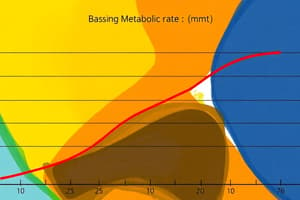Podcast
Questions and Answers
What percentage of adults in the US are considered overweight or obese?
What percentage of adults in the US are considered overweight or obese?
- 75.2%
- 50.5%
- 68.8% (correct)
- 35.7% (correct)
Which group tends to store excess fat mainly in the lower body?
Which group tends to store excess fat mainly in the lower body?
- Children
- Premenopausal women (correct)
- Postmenopausal women
- Men
What contributes to the imbalance in body fat distribution among different ethnic groups?
What contributes to the imbalance in body fat distribution among different ethnic groups?
- Dietary habits (correct)
- Physical activity levels
- Waist circumference (correct)
- Genetic factors only
What is a healthier alternative to calorie-dense items?
What is a healthier alternative to calorie-dense items?
How much of their total daily calories do Americans consume in empty forms?
How much of their total daily calories do Americans consume in empty forms?
Which of the following is recommended for maintaining a healthy diet?
Which of the following is recommended for maintaining a healthy diet?
What is the relationship between abdominal fat storage and health risks?
What is the relationship between abdominal fat storage and health risks?
What should eating be primarily motivated by?
What should eating be primarily motivated by?
What can help avoid binge eating when experiencing hunger?
What can help avoid binge eating when experiencing hunger?
What is a potential risk of consuming commercially pre-packaged foods labeled as 'fat-free' or 'sugar-free'?
What is a potential risk of consuming commercially pre-packaged foods labeled as 'fat-free' or 'sugar-free'?
What relationship has been observed between breakfast frequency and obesity risk?
What relationship has been observed between breakfast frequency and obesity risk?
How have portion sizes changed over the past 20 years?
How have portion sizes changed over the past 20 years?
Which type of exercise is noted to help improve bone density?
Which type of exercise is noted to help improve bone density?
What is 'portion distortion' likely to lead to?
What is 'portion distortion' likely to lead to?
What impact does sedentary behavior have on health?
What impact does sedentary behavior have on health?
How does aging typically affect calorie requirements?
How does aging typically affect calorie requirements?
What is the Basal Metabolic Rate (BMR)?
What is the Basal Metabolic Rate (BMR)?
What strategy can help combat overconsumption due to larger portion sizes?
What strategy can help combat overconsumption due to larger portion sizes?
Which factor contributes the most to total energy expenditure?
Which factor contributes the most to total energy expenditure?
What does Resting Metabolic Rate (RMR) include in its calculations?
What does Resting Metabolic Rate (RMR) include in its calculations?
What percentage of total calorie usage does physical activity contribute?
What percentage of total calorie usage does physical activity contribute?
What is the thermic effect of food estimated to be, in relation to total calorie intake?
What is the thermic effect of food estimated to be, in relation to total calorie intake?
Which method is commonly used to estimate daily calorie needs for nonobese adults?
Which method is commonly used to estimate daily calorie needs for nonobese adults?
What is the impact of weight on calorie burning during physical activity?
What is the impact of weight on calorie burning during physical activity?
What is a primary factor influencing the estimation of calorie requirements?
What is a primary factor influencing the estimation of calorie requirements?
Which method is recommended for estimating 'ideal' body weight (IBW) in clinical settings?
Which method is recommended for estimating 'ideal' body weight (IBW) in clinical settings?
How is body mass index (BMI) viewed in relation to traditional height-weight measurements?
How is body mass index (BMI) viewed in relation to traditional height-weight measurements?
Which of the following is NOT a complex factor related to healthy weight?
Which of the following is NOT a complex factor related to healthy weight?
Why is the thermic effect often underestimated in calorie requirements?
Why is the thermic effect often underestimated in calorie requirements?
What does healthy weight relate to in the context of overall health?
What does healthy weight relate to in the context of overall health?
Which of the following measurements provides standards for evaluating ideal body weight?
Which of the following measurements provides standards for evaluating ideal body weight?
What is a limitation of the standards for body weight evaluations?
What is a limitation of the standards for body weight evaluations?
What is the recommended weight for a man who is 5 ft 6 in tall according to the ideal weight formula?
What is the recommended weight for a man who is 5 ft 6 in tall according to the ideal weight formula?
How does BMI calculation differ for men and women when considering height?
How does BMI calculation differ for men and women when considering height?
Why might waist circumference be considered a better measure than BMI in certain subpopulations?
Why might waist circumference be considered a better measure than BMI in certain subpopulations?
What adjustment is suggested for ideal body weight for individuals with smaller frames?
What adjustment is suggested for ideal body weight for individuals with smaller frames?
What happens in a positive energy balance?
What happens in a positive energy balance?
What is a limitation of using BMI as a measure of health?
What is a limitation of using BMI as a measure of health?
For individuals shorter than 5 ft, how is the ideal body weight adjusted?
For individuals shorter than 5 ft, how is the ideal body weight adjusted?
What is a characteristic of BMI levels that classify overweight and obesity?
What is a characteristic of BMI levels that classify overweight and obesity?
Study Notes
Basal Metabolic Rate (BMR)
- Measures the calories the body burns at rest after a 12-hour fast.
- Represents involuntary activities like breathing, heart rate, and organ function.
- Resting Metabolic Rate (RMR) is slightly higher because it includes energy spent on digestion.
Total Energy Expenditure (TEE)
- Physical activity accounts for approximately 30% of total calorie usage.
- Heavier individuals burn more calories.
- Predicting TEE precisely is difficult due to the many factors involved.
Estimating Basal Metabolic Rate (BMR)
- Use predictive equations, but these are estimations, not precise measurements.
- Several formulas exist for estimating BMR, but they all have limitations.
- Can be estimated using a simple formula of calories per kilogram of body weight (25-30 cal/kg for nonobese adults).
- Adjust this formula based on age, weight, and activity level.
Estimating Daily Calorie Needs
- Consult standard references that list estimated daily calorie needs based on gender, age, and activity level.
- Use the rule-of-thumb methods for BMR and add the estimated calories spent on activity.
The Thermic Effect of Food
- Refers to the calories spent processing food.
- Estimated to be 10% of total calorie intake in a normal mixed diet.
- Varies based on food composition, frequency, and meal size.
- Often underestimated when estimating calorie requirements.
Healthy Weight
- Statistically related to good health, but more complex than just weight.
- Body fat, distribution, and health risks also influence weight.
- Existing standards for evaluating ideal body weight, BMI, and waist circumference are arbitrary due to the continuous relationship between increasing weight and disease risk.
Ideal Body Weight (IBW) - Hamwi Method
- Uses height and gender to estimate IBW.
- For women: 100 pounds for the first 5 feet, add 5 pounds for each additional inch.
- For men: 106 pounds for the first 5 feet, add 6 pounds for each additional inch.
- Adjust IBW upward or downward by 10% based on frame size.
Body Mass Index (BMI)
- Used in clinical settings to identify adults with excess weight.
- Calculated by dividing weight in kilograms by height in meters squared (or weight in pounds by height in inches squared multiplied by 703).
- Uses nomograms and tables to determine BMI.
- Levels defining overweight and obesity are arbitrary due to the continuous relationship between increasing weight and disease risk.
- Doesn't take body composition or ethnic differences into account.
Waist Circumference
- May be a more reliable indicator of disease risk than BMI for some subpopulations.
- Location of excess body fat is important, with abdominal fat increasing risks for type 2 diabetes and cardiovascular disease.
- Men and postmenopausal women tend to store fat in the upper body, while premenopausal women store it in the lower body.
- Ethnic groups have varying risk thresholds for waist circumference.
Energy Balance
- The relationship between calorie intake and output.
- Positive balance occurs when intake exceeds output, leading to weight gain.
- Negative balance occurs when output exceeds intake.
- 68.8% of American adults are overweight or obese, increasing the risk of various health issues.
- Poor food choices and physical inactivity contribute to energy imbalance, leading to increased calorie intake and decreased expenditure.
State of Energy Balance:
- Choose Nutrient-Dense, Not Calorie-Dense Items: Focus on fruits, vegetables, whole grains, legumes, nuts, nonfat milk, and lean proteins.
- Maintain a Consistent Eating Pattern: Avoid going long periods without eating to prevent overeating when hungry.
- Eat Only to Relieve Hunger: Avoid eating out of boredom or stress.
- Avoid Commercially Pre-packaged "Junk" Foods: Beware of "fat-free" or "sugar-free" foods, as they can still contain calories.
- Breakfast is Important for Children and Adults: Observational studies show a link between infrequent breakfast consumption and increased risk of obesity and chronic diseases.
Activity Choices: Move More, Sit Less
- Increased activity levels are dose-dependent and can vary from 2 to 5 hours per week.
- Muscle-strengthening activities like weightlifting, resistance training, and endurance exercises help build muscle, raise metabolic rate, and increase weight loss.
- These activities also improve bone density.
- Sedentary behavior increases the risk of weight gain, obesity, and chronic diseases.
Right Portion Sizes
- Portion sizes have significantly increased over the past 20 years.
- Grocery stores and restaurants often sell and offer jumbo portions that are much larger than standard servings.
- Changes in dishware size can also increase calorie intake.
- This "portion distortion" can affect people's perception of food intake, leading to overconsumption.
- To combat this, strategies include switching to smaller dishware and limiting access to large portions.
Studying That Suits You
Use AI to generate personalized quizzes and flashcards to suit your learning preferences.
Related Documents
Description
This quiz explores key concepts related to Basal Metabolic Rate (BMR) and Total Energy Expenditure (TEE). Learn how these measurements are calculated and what factors influence daily calorie needs. Test your knowledge on the predictive equations and formulas used for estimating calorie requirements.




